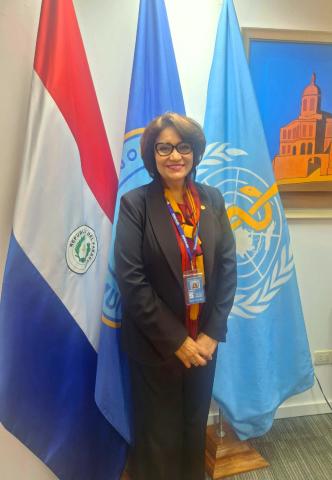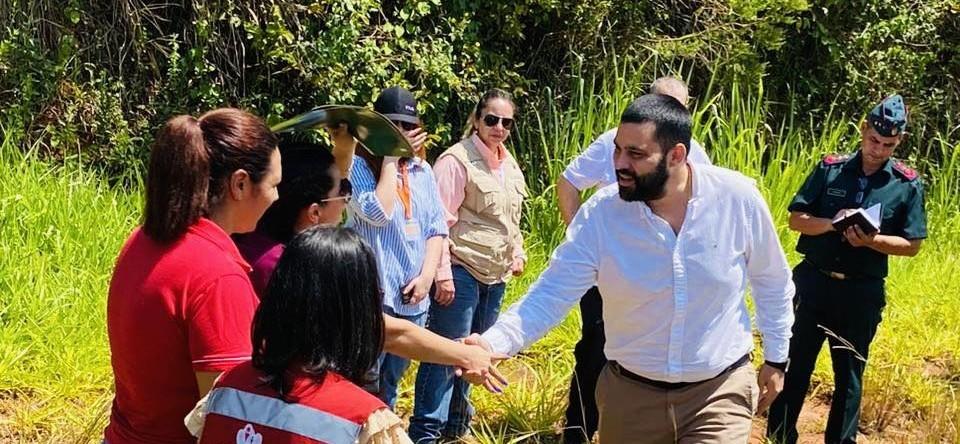The Government of Paraguay has injected renewed energy in its primary health care system to address the urgent health challenges that indigenous people face and bring services closer to where people live.
Previously, indigenous communities in Northeast Paraguay have struggled to access the health services they need despite increasing rates of communicable and noncommunicable diseases.
Results are already evident. In 2023-2024, access to health services increased by 8%, the number of primary care visits increased by 10.5%, and the number of overall medical consultations increased by 19%.
The Ministry of Public Health and Social Welfare has worked closely with PAHO/WHO, through the UHC Partnership, to expand access to and improve the quality of primary health care services at the community level, with family health teams playing a major role.
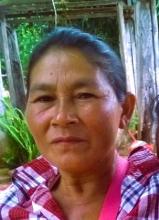
“I came with my whole family. We have several ailments, but the main one is the flu. We are very happy, they treated us all very well.”
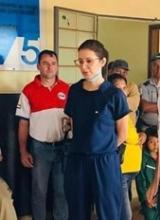
"The analysis helped me observe the current weaknesses and strengths in my health service in relation to human resources, infrastructure, equipment, and access. It also provided us with information on how to coordinate with other health facilities to avoid delays or overloads on the health system."
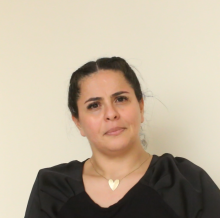
“There are many activities that do not require a large investment such as providing training to health workers on protocols which can be done virtually. I believe this benefit will be reflected in fewer patients reaching critical conditions.”
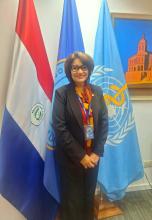
“We capitalized on lessons learned from previous experiences, which allowed for a more effective and sustainable approach. Joint work with local actors and the incorporation of intercultural dialogue and community-based health care were essential in closing historical access gaps. Furthermore, the implementation of intersectoral work reinforces the positive impact of this cooperation. This experience confirms that international collaboration, aligned with national priorities, can generate real and lasting transformations in health systems.”
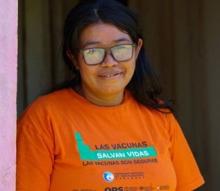
“Now I feel good, I feel happy, because if someone comes at night with high blood pressure, I have everything to attend to them. I also have the resources to provide first aid, and I can administer first aid.”
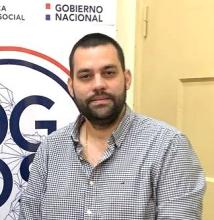
“The cooperation between the XIV Canindeyú Health Region and PAHO has been a fundamental pillar in the transformation and strengthening of the region's health system. The implementation of strategic actions has allowed for the improvement of health infrastructure, expanded care coverage, strengthened the training of health personnel, and optimized the response to health emergencies. We deeply appreciate PAHO's support in the implementation of these initiatives. The results achieved demonstrate the positive impact of this joint work.”
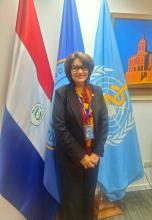
“The implementation of the project in Canindeyú, with the valuable support of the UHC Partnership, clearly reflects our inter-programmatic and territorial approach. This initiative was aligned with the country's efforts to advance health equity by strengthening local capacities, promoting the use of innovative technologies, and ensuring appropriate care tailored to cultural and territorial realities.”
Joaquina Portillo is an indigenous elderly resident from the rural community of Rio Verde, Department of Canindeyú, Northeast Paraguay. She recently attended an outpatient care day hosted in her community and was very pleased with the comprehensive care that she and her family received.
“I came with my whole family. We have several ailments, but the main one is the flu. We are very happy, they treated us all very well,” said Joaquina.
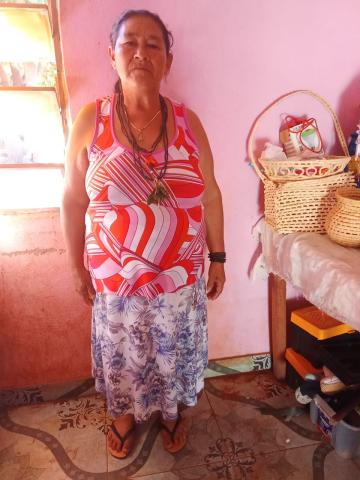
The outpatient care day, one of many held locally, promotes dialogue between health care providers and indigenous and rural communities about intercultural care and provides a range of health services through outreach activities. This activity was part of a broader project called Expanding Access to and Quality of Primary Health Care and Integrated Health Services in the XIV Health Region - Canindeyú, Paraguay, from 2023 - 2025.
Canindeyú is a historically marginalized department in Paraguay with a long history of insecurity, localized political problems, and limited presence of national authorities. With 133 indigenous communities, the Department of Canindeyú has second largest number of indigenous communities in the country.
The IV National Indigenous Census 2022 showed that about 88% of the indigenous population in Paraguay lives in rural areas, many of which are difficult to access. This in turn makes it difficult for health teams to reach them and provide timely care. Most homes have dirt floors and only 25% have running water. Although 77% of communities receive services from a Family Health Unit, effective use varies significantly. Communities in the Western region, for example, have greater coverage of indigenous health promoters than those in the Eastern region where Canindeyú is located. Home births are predominant, and care by indigenous midwives remains common. As a result, the country's indigenous population faces a significant prevalence of infectious and poverty-related diseases such as tuberculosis. At the same time, some studies show that the indigenous population faces a growing burden of chronic non-communicable diseases (NCDs), with high rates of high blood pressure, diabetes, and obesity.
Progress on multiple fronts
This outpatient care day was part of an inter-programmatic and interdisciplinary initiative of PAHO/WHO, through the Universal Health Coverage (UHC) Partnership, working closely with Paraguay’s Ministry of Public Health and Social Welfare. The work included developing and implementing a tool for monitoring and managing health services using geospatial data about family health units, training health workers especially in the control of communicable and noncommunicable diseases, and strategic Health Situation Analysis to facilitate the design of effective health policies.
The initiative has enabled progress on multiple fronts to improve health services in Canindeyú including expanding access to health care for vulnerable populations, strengthening trust in public health services among indigenous and rural populations, increasing the technical capacity of health workers, and optimizing responses to health emergencies.
Across the Department from 2022-2024 health insurance coverage increased by 18.1% and access to health services increased by 25.1%. From April-June 2023 to April-June 2024 the number of primary care visits increased by 10.5%, and the number of overall medical consultations increased by 19%. In the same period, there was also a 29% increase in the proportion of pregnant women who received an HIV and Syphilis test during the first trimester of pregnancy.
The UHC Partnership operates in over 125 countries, representing over 3 billion people. It is supported and funded by Belgium, Canada, the European Union, France, Germany, Ireland, Luxembourg, Japan, the United Kingdom of Great Britain and Northern Ireland, and WHO.
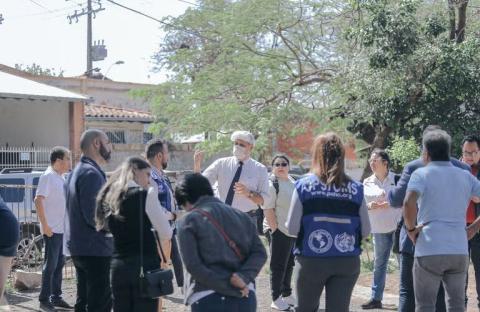
Geospatial analysis helps strengthen PHC services
The initiative supported the design and implementation of a tool and dashboard for monitoring and managing health services. This tool is based on evidence and geospatial information on the capacity and performance of services at Family Health Units. It was developed with the Ministry of Public Health and piloted in Canindeyú with subsequent implementation in more than 900 Family Health Units across the country.
The innovative use of geospatial technologies in health has enabled short-term analyses of health service accessibility and the prioritization of investments in primary care, specifically the construction of new Family Health Units in urban and rural settings.
The tool improved service management by identifying and monitoring areas with gaps in access to services, the location of vulnerable populations, and the prioritization of interventions based on territorial needs. By integrating geographic data into health service planning, it became possible to allocate resources more efficiently, improve coverage of essential services, and ensure that primary health care expansion strategies are aligned with local realities. This strengthens the impact on equity and community well-being.
A participatory development process involved health professionals from all districts and levels of care within the Canindeyú Ministry of Public Health and Social Welfare. The situation in the Canindeyú Health Region was analysed using the attributes of the Integrated and Comprehensive Health Service Networks (RIISS) as defined by the Ministry of Public Health and Social Welfare. The focus was on the comprehensive care model to address the needs of people diagnosed with high blood pressure and diabetes mellitus, as a replicable model for other health needs.
"The analysis helped me observe the current weaknesses and strengths in my health service in relation to human resources, infrastructure, equipment, and access. It also provided us with information on how to coordinate with other health facilities to avoid delays or overloads on the health system," said Dr Sara Hernández, who leads the Family Health Unit in Ypejhú.
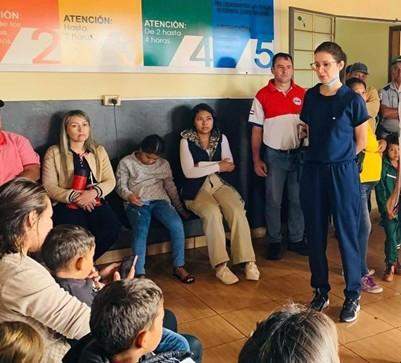
PAHO/WHO’s Modular Essential Conditions Assessment
Created by PAHO/WHO, the ‘Modular Essential Conditions Assessment’ methodology (VCEm in Spanish) evaluates essential factors for the provision of services in health facilities. It was implemented in 14 health regions, including Canindeyú, to drive sustainable improvement within health service networks and to empower health workers. The methodology reveals significant changes that can be made with little or no investment.
“There are many activities that do not require a large investment such as providing training to health workers on protocols which can be done virtually. I believe this benefit will be reflected in fewer patients reaching critical conditions,” said Dr Angie Duarte, Director of the Curuguaty District Hospital.
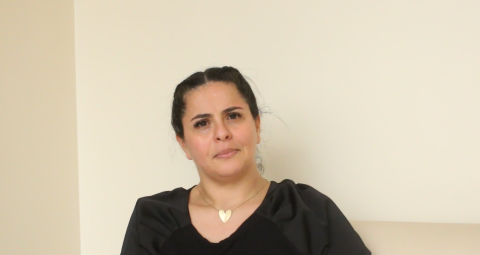
The implementation of the modular VCEm at the Canindeyú RISS facilities identified opportunities to improve and prioritize actions to promote inclusive, equitable, and culturally appropriate health services that maintain respect for traditional medical knowledge and foster intercultural dialogue.
The assessment also highlighted that when communities trust and feel supported by health workers in their community, they are more likely to return to use the available services. The methodology is a catalyst for continuous improvement in health facilities that have a profound impact on the communities they serve.
Intercultural dialogues
Intercultural dialogues took place in the indigenous communities of San Antonio, Ko'e Porã (Villa Ygatimi district) and Fortuna (Curuguaty district), near the Mbaracayú Forest Nature Reserve. The dialogues were held among local authorities, local health teams, communal authorities, empirical midwives, indigenous doctors, religious leaders and/or shamans, community leaders, and wise men and elders, in a space that was designated as "sacred." In this space, participants identified the need to strengthen collaboration between health professionals and leaders of indigenous communities and highlighted the fundamental role of indigenous health promoters for comprehensive, equitable, and respectful care for cultural diversity.
The dialogues made it possible to identify the health care needs of women and the indigenous population, especially midwives as bearers of traditional knowledge, beliefs, and practices. Furthermore, the validation of ancestral knowledge and the indigenous worldview regarding their own health system was highlighted. Likewise, equity and non-discrimination in access to public health for indigenous communities and the protection of forests were also emphasized, both to guarantee the environmental health of the communities and to preserve the poha (medicinal herbs, in the Guarani language), which exists as long as forests exist.

Strengthening the health workforce
Approximately 1 300 health workers participated in Ministry of Public Health training courses, which were supported by PAHO/WHO. Training took place on monitoring strategies, early case identification, activating control protocols for disease outbreaks, and implementing early warning systems and communication networks for immediate responses to health emergencies. As a result, health workers have increased their technical capacity in epidemiological surveillance and rapid response to epidemic outbreaks such as dengue, tuberculosis, leishmaniasis, and measles. This has improved control and mitigation of the spread of these diseases and strengthened the planning of preventive actions to minimize their impact.
Already, people’s health is improving and lives are being saved. Following a WHO training, doctors were able to recognize and treat meningitis, saving the lives of two patients. After a training on identifying measles outbreaks, health workers followed up on several suspected local cases which later proved to be negative.
Other training topics included the control and prevention of noncommunicable diseases such as hypertension and cervical cancer; cessation of smoking; mental health surveillance; hospital waste management; oral health; and quality of care and patient safety.
“Now I feel good, I feel happy, because if someone comes at night with high blood pressure, I have everything to attend to them. I also have the resources to provide first aid, and I can administer first aid,” said Natalia Saucedo, responsible for the Dispensary Tekohá Y’ Apo from the Ava Guaraní Indigenous Community.
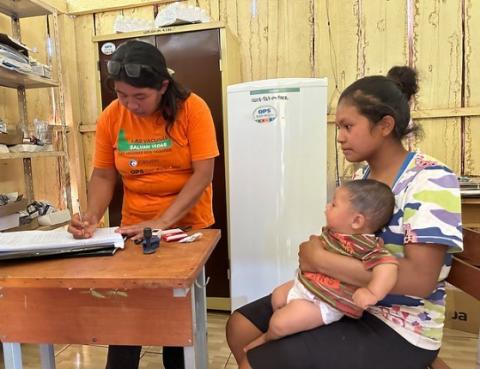
The 2024-2030 Health and Human Resources Training Plan for the XIV Canindeyú Health Region, developed with support from PAHO/WHO, has further strengthened competencies with an emphasis on comprehensive health care and a life-course approach. As a result, health workers have improved skills to provide integrated, people-centred care and can foster more collaborative and networked ways of working. Knowledge management tools such as virtual tools, telemedicine, and telehealth, among others, have been promoted and disseminated to support effective health service delivery.
Policy design and implementation
The strategic alliance between PAHO/WHO and the XIV Health Region of Canindeyú has increased the visibility and strengthened the presence of the central level of the Ministry of Public Health and Social Welfare. This has promoted continued support for technical cooperation and initiatives in coordination with health authorities.
PAHO/WHO and the XIV Health Region of Canindeyú collaborated on developing the first Health Situation Analysis for Canindeyú. This facilitated the design of policies to address critical issues such as health workforce, chronic diseases, vector-borne infections, and traffic accidents.
“The cooperation between the XIV Canindeyú Health Region and PAHO has been a fundamental pillar in the transformation and strengthening of the region's health system. The implementation of strategic actions has allowed for the improvement of health infrastructure, expanded care coverage, strengthened the training of health personnel, and optimized the response to health emergencies. We deeply appreciate PAHO's support in the implementation of these initiatives. The results achieved demonstrate the positive impact of this joint work,” said Dr Sergio Ambrasath, Regional Director of the XIV Canindeyú Health Region.
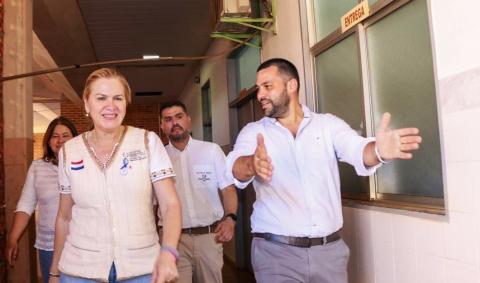
Summary
“The implementation of the project in Canindeyú, with the valuable support of the UHC Partnership, clearly reflects our inter-programmatic and territorial approach. This initiative was aligned with the country's efforts to advance health equity by strengthening local capacities, promoting the use of innovative technologies, and ensuring appropriate care tailored to cultural and territorial realities,” said Dr Haydee Padilla, PAHO/WHO Representative a.i. to Paraguay.
“We capitalized on lessons learned from previous experiences, which allowed for a more effective and sustainable approach. Joint work with local actors and the incorporation of intercultural dialogue and community-based health care were essential in closing historical access gaps. Furthermore, the implementation of intersectoral work reinforces the positive impact of this cooperation. This experience confirms that international collaboration, aligned with national priorities, can generate real and lasting transformations in health systems,” Dr Haydee Padilla concluded.
